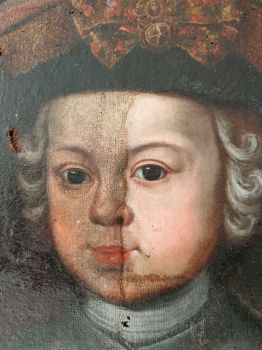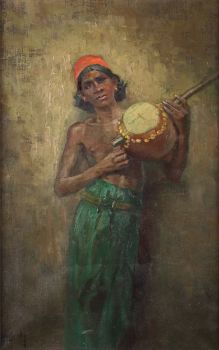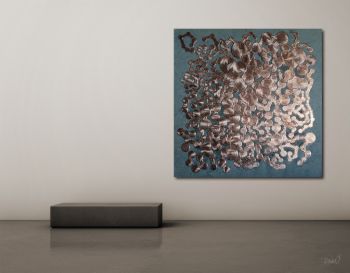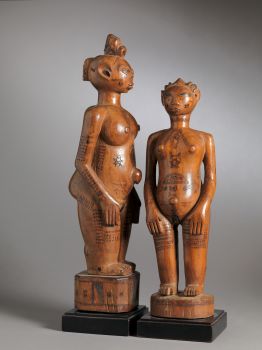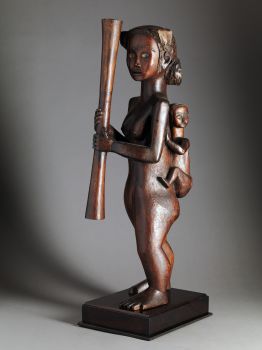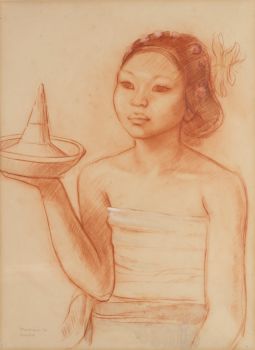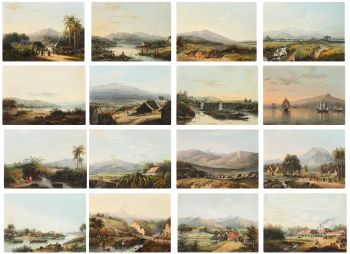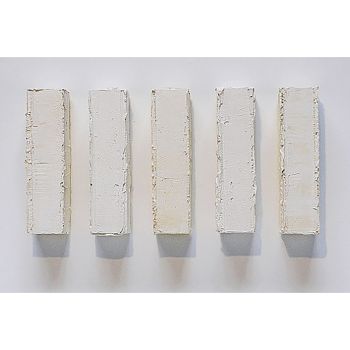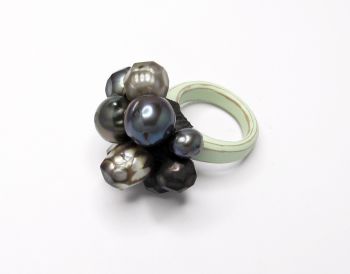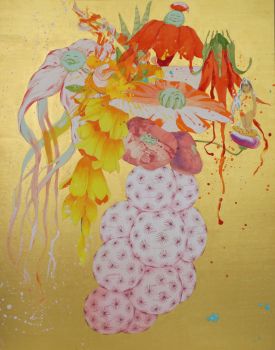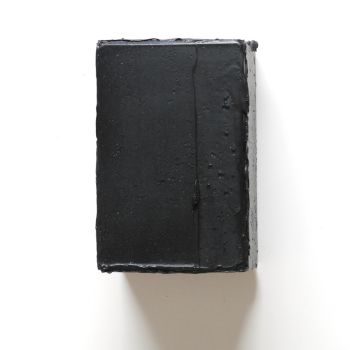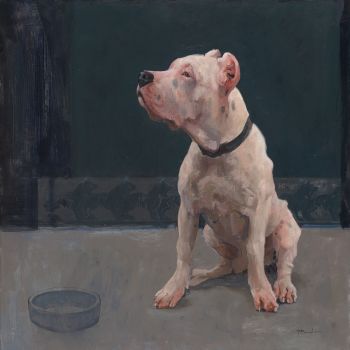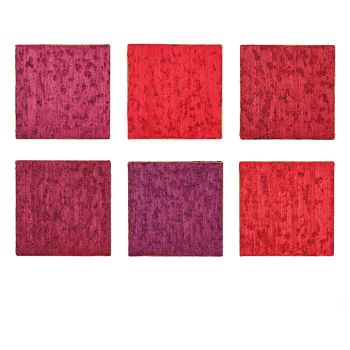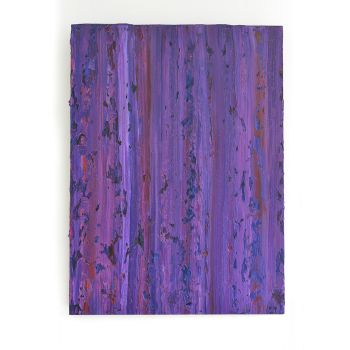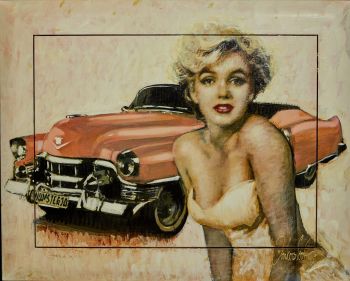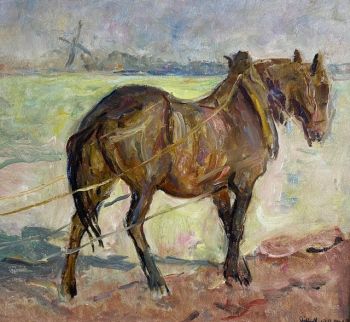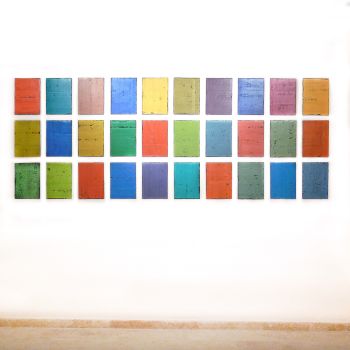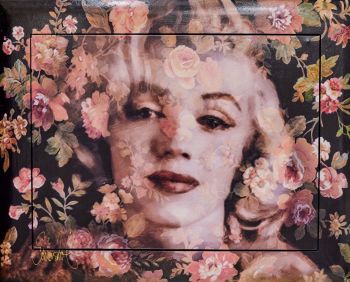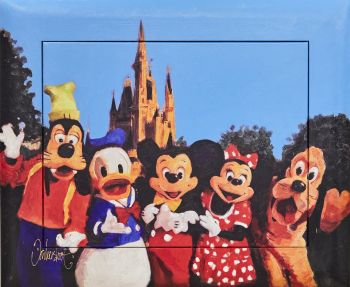A pair of Javanese wooden polychrome painted wall panels, c. 1900 1900
Artista Desconocido
Madera
71 ⨯ 49 cm
ConditionGood
€ 1.200
Menken Works of Art
- Sobre la obra de arteAn exquisite pair of carved wooden polychrome relief hand-painted panels in original frames.
Java (Indonesia), late 19th / early 20th century.
The figure on the left panel of the first picture representing Brajadenta. With text at the bottom: 'R.Soeratinin Aro'.
The figure on the right panel of the first picture representing wayang figure Bratasena, the young Bima. With text at the bottom: 'R.(=Raden) Brontoseno. Soerabaja', followed by a date.
A fine example of Javanese folk art
In some parts of Java, wooden plaques like these were placed on the wall around the entrance of the house, to protect the residents from evil spirits.
Dimensions with frames:
Length 71 cm, width 49,5 cm.
Dimensions without frames:
Length 56 cm, width 34,5 cm
Condition:
In a good old condition with some wear - see pictures.
Provenance:
From the collection of Dr. Hedi Hinzler, Leiden, the Netherlands.
Ref:
Soebadio, Haryati - Pusaka Indonesische kunstschatten, p. 173.
Worldwide registered and insured shipping.
Take a look at our other listings for more Asian art, antiques, design, etc.
Inv. No: A00281
-
The story behind the two Wayang figures:
Bratasena:
This puppet represents the character of the Bima also known as Bratasena (Bhima) in the Hindu epic Mahabharata which is performed in the Javanese wayang kulit, or leather shadow puppet theatre tradition. Bima is one of the five Pandava brothers and is recognised by his large thumbnail, that he used to attack his enemies.
Brajadenta:
Brajadenta is the third son of Prabu Arimbaka (Kala Tremboko), the giant king of the Pringgandani state with Dewi Hadimba.
Brajadenta has a stubborn character, wants to win alone, is brave and wants to always follow his heart. He was very powerful, because of that his older brother, Dewi Arimbi, appointed him as the deputy king to hold the reigns of government for the Pringgandani state as long as Dewi Arimbi accompanied her husband Werkudara to live in Jadipati.
At the end of his story, it is told that because he disagreed with the appointment of Gatotkaca, the son of Dewi Arimbi and Werkudara as king of Pringgandani, Brajadenta, assisted by his three younger brothers, Brajamusti, Brajalamatan and Brajawikalpa, rebelled because he wanted to absolutely control the country of Pringgandani.
Gatotkaca crushed his rebellion with the deaths of Brajalamatan and Brajawikalpa. Brajadenta and Brajamusti managed to escape and take refuge in their nephew Prabu Arimbaji, the son of the late Prabu Arimba who had become king in the country of Gowasiluman in the Tunggarana forest. With the help of Bathari Durga, Brajadenta entered Pringgandini's country again to kill Gatotkaca.
His efforts again failed. Brajadenta finally died in the battle against Gatotkaca.
His spirit incarnated into an enchantment / magic and entered / merged into Gatotkaca's teeth. Since then Gatotkaca has supernatural powers; whoever gets bitten by it will surely perish. - Sobre el artista
Puede suceder que un artista o creador sea desconocido.
Algunas obras no deben determinarse por quién está hecho o por (un grupo de) artesanos. Algunos ejemplos son estatuas de la Antigüedad, muebles, espejos o firmas que no son claras o legibles, pero también algunas obras no están firmadas en absoluto.
También puedes encontrar la siguiente descripción:
•"Atribuido a …." En su opinión, probablemente una obra del artista, al menos en parte.
•“Estudio de….” o “Taller de” En su opinión, una obra ejecutada en el estudio o taller del artista, posiblemente bajo su supervisión
•“Círculo de…” En su opinión, una obra del período del artista que muestra su influencia, estrechamente asociado con el artista pero no necesariamente su alumno.
•"Estilo de …." o “Seguidor de…”. En su opinión, una obra ejecutada al estilo del artista pero no necesariamente por un alumno; puede ser contemporáneo o casi contemporáneo
•"Manera de …." En su opinión una obra al estilo del artista pero de fecha posterior
•"Después …." En su opinión, una copia (de cualquier fecha) de una obra del artista
•“Firmado…”, “Fechado…” o “Inscrito” En su opinión, la obra ha sido firmada/fechada/inscrita por el artista. La adición de un signo de interrogación indica un elemento de duda.
•“Con firma…”, “Con fecha…”, “Con inscripción…” o “Lleva firma/fecha/inscripción” en su opinión la firma/fecha/inscripción ha sido añadida por alguien que no es el artista
¿Está interesado en comprar esta obra de arte?
Artwork details
Related artworks
Artista Desconocido
Enchanting 1870s Vintage Fly Brooch: Victorian Elegance in Gold1870
€ 4.600Adin Fine Antique Jewellery
 curada por
curada porDanny Bree
Artista Desconocido
Cáliz veneciano alado1650 - 1700
Precio a consultarPeter Korf de Gidts - Antiquairs
1 - 4 / 12Artista Desconocido
Chinese carnelian agate vase or brush washer, 18th/19th century, Qing dynasty1720 - 1820
Precio a consultarMenken Works of Art
HUGO VILFRED VON PEDERSEN
Gadesanger fra Singapore (Musician from Singapore)1870 - 1959
Precio a consultarZebregs & Röell - Fine Art - Antiques
1 - 4 / 13Artista Desconocido
Couple Wooden Ancestors Sculptures with Scarifications, Zela People, DRC. 1920 - 1930
Precio a consultarSpectandum Gallery
Artista Desconocido
MATERNITY FIGURE, FANG-MABEA, CAMEROON.PROVENANCE R.CAILLOIS-P.RATTON.1920 - 1930
Precio a consultarSpectandum Gallery
1 - 3 / 3Thea G.F. Eschauzier
Retrato de una niña javanesa1931
Precio a consultarZebregs & Röell - Fine Art - Antiques
Theo Meier
Una mujer balinesa con ofrendas1936
Precio a consultarZebregs & Röell - Fine Art - Antiques
Abraham Salm
Twenty-four chromolithographs of Java after A. Salm”1801 - 1876
Precio a consultarZebregs & Röell - Fine Art - Antiques
Artista Desconocido
A Dutch colonial Indonesian betel box with gold mounts1750 - 1800
Precio a consultarZebregs & Röell - Fine Art - Antiques
Artista Desconocido
A superb Indonesian royal gem-set gold overlaid silver betel box19th century
Precio a consultarZebregs & Röell - Fine Art - Antiques
1 - 4 / 12Firm Erhard & Sohne, Schwäbisch Gmünd
Erhard und Söhne – Jugendstil intarsia klok – 1908 / 19091900 - 1909
Precio a consultarAntiques Emporium
1 - 4 / 24Artista Desconocido
A white jade ‘Lotus Seedpod and Bug’ carving, Qing dynasty, 18th century18th century
Precio a consultarMenken Works of Art
Artista Desconocido
Chinese gilt bronze censer, Xuande mark, 18th century, Qing dynasty18th century
Precio a consultarMenken Works of Art
Artista Desconocido
Chinese carnelian agate vase or brush washer, 18th/19th century, Qing dynasty1720 - 1820
Precio a consultarMenken Works of Art
1 - 4 / 11












